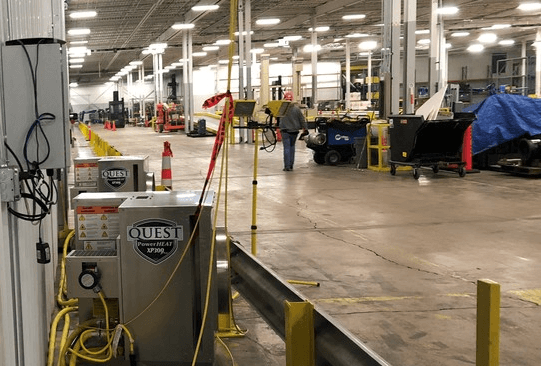Hazard-Free Construction Heaters
Posted by Matt Milos on Oct 11th 2018
 The construction industry is evolving.
The construction industry is evolving.
Winter is no longer the guaranteed "off-season" for construction in the way it used to be. Tighter production schedules leave less and less room for delays. On top of this, increased air quality regulations and low V.O.C. products provide safer alternatives for construction heaters but often do so at the cost of the schedule.

Hydronic heat is the industry's best answer to shrinking schedules and increased regulations.
It follows, then, that the tools that we rely on would need to evolve as well. At one time the only construction heaters available for a project were the open-flame heater or the indirect-fired heater. Though both still see a lot of use, a new contender is quickly making strides in the industry: hydronic heating.
Seeing a void, a few companies started adapting hydronic ground-thaw equipment for structural construction heaters.
An intelligent design for sure, and there is no denying that hydronic heat checks all the needed boxes for construction:

Click on the links for more information on each feature.
Quiet operation
There was only one potential drawback: hoses.
The system works like a boiler, pumping hot glycol through hoses to evenly distribute heat through the structure. When most people think of a hose system they think of the picture at the right: a network of trip and puncture hazards. In fact, someone once suggested that, to be truly perfect, the hydronic system needed to be hose-less. Is this possible? More importantly, is this even necessary?

Do potential trip and puncture hazards undermine the practicality of hydronic heat?
Before I address this question, however, I'd like to make a note.
Though open-flame and indirect-fired construction heaters do not use glycol hoses, they are not without similar hazards. An open-flame heater requires a separate gas line or hose run to each individual unit on-site. Indirect-fired heaters, on the other hand, centralize the fuel supply but require fans to circulate heat through the building. One features trip and explosion hazards, while the other litters the structure with fans and is extremely inefficient. This brings us back to the question: are hydronic construction heaters more dangerous because they use hoses?
Hydronic technology has also evolved in recent years.
Hoses were once 2” in diameter, had awkward ball-valve couplings, and weighed in at a staggering 150lbs per 50 foot section. Nowadays these hoses are half of the diameter, are a third of the weight, and have easy-use couplings. Improvements for sure, but the hoses are still in the way.
This is where the exchangers play a role.

Hydronic's power and efficiency allow for contractors to keep both exchangers and hoses out of the way.
Reverse impeller drive motors have replaced the less advanced "squirrel cage" fans. With a higher static pressure of air-flow, these motors move much more air and allow for previously unseen levels of on-site recirculation. This means contractors can place exchangers wherever it is most convenient and still evenly distribute heat. Hoses can run directly from the heating unit up the side or along the exterior of a structure, piping directly into the exchanger by the exterior wall. Clean, simple, and, most importantly, tucked out of the way. Practically hose-less.

Do you see any hoses here?

